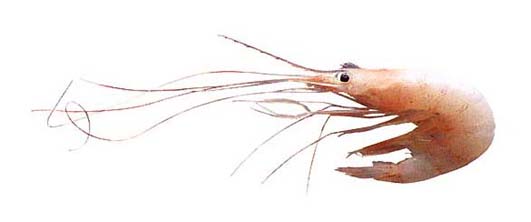テナガエビ科(Palaemonidae)

ツノナガシロエビ(Whitebelly prawn)
Nematopalaemon schmitti (Holthuis, 1950)
特 徴:
体長7cm。白色の繊細な感じの小形種。頭胸甲は円筒状で,触角上棘と鰓前棘以外は特別のとげや溝はない。額角は頭胸甲の2倍の長さに達し,基部1/4ほどの部分から前方が斜め上方を向く。上縁は眼窩底部のレベルで強く板状に盛り上がり,3,4歯と羽状毛がある。また,先端近くに小さなとげがある。下縁は全長にわたってほぼ等距離に6本のとげがあり,第1のとげまでは羽状毛の縁取りがある。胸脚は著しく細長い。前2対ははさみをもち,第2対めが他の胸脚よりやや太い。その長節は基部近くがふくらみ,腕節は先太り,掌部は長節のふくらんだ部分と同じくらいの太さで,指の半分ほどの長さである。
採集記録:
水深15〜50m(多数)。
分 布:
ベネズエラからブラジル北東部まで。水深5〜75m。
備 考:
色彩でも区別がつくが,クルマエビ科のシーボブ,モエビ科のトゲヒゲナガモエビに額角の形態がよく似ている。いずれも同海域に分布し,同じようにむき蝦や干し蝦として利用されている。
Diagnostic characters:
A white small species. Carapace cylindrical without any grooves or spines, except for usual antennal and pterygostomial spines. Rostrum about twice as long as carapace, curving obliquely upward at basal one-fourth; upper margin with a three-or four-toothed crest at level of bottom of orbit, and usually with a subterminal small spine; lower margin with six equidistant spines, and with a fringe of plumose hairs at its basal part to first spine. Pereiopods markedly slender, and first two pairs chelate, second pair being slightly stouter than the others; in second pair merus bulged basally, carpus widening distally, and palm as thick as basal part of merus and half as long as fingers.
Distribution:
West Atlantic from Venezuela to northeast coast of Brazil, 5-75 m deep.
Remarks:
General appearance of the carapace and rostrum is unexpectedly close to Xiphopenaeus kroyeri (Heller) of the Penaeidae and Exhippolysmata oplophoroides (Holthuis) of the Hippolytidae, which are distributed in the same localities and used as food in the same way as this species.
- 1